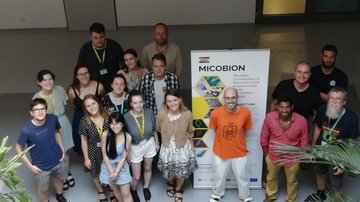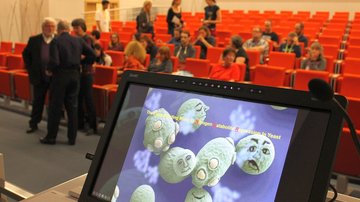
MiCoBion
Q&A: Why history suggests Covid-19 is here to stay
A mysterious flu-like illness that caused loss of taste and smell in the late 19th century was probably caused by a coronavirus that still causes the ‘common cold’ in people today, according to Professor Marc Van Ranst at KU Leuven in Belgium, an expert on coronaviruses.
He says that the foothold of the SARS-CoV-2 virus in the human population today means it is likely to follow a similar pattern and become a continuously circulating, or ‘endemic’ virus, joining four other human coronaviruses that infect people with common cold symptoms.
Could you tell us about your work showing that a coronavirus called OC43 may have caused the ‘Russian flu’ pandemic of the 1890s, which spread from St Petersburg across Europe to the US?
Yes, the first study was in 2005. We redid the genetic analysis (of OC43 evolution) to see at what point the bovine and the human viruses started to diverge (which indicates OC43 jumped species) and we found exactly the same date (as the Russian flu epidemic). Even at the time people were debating about the cause of this weird flu, though they did not even know about viruses. But it was striking even then that this might be something different.
In recent months, journalists have searched through archives and, especially in Russia, they found old newspaper articles with references to the loss of taste and the loss of smell, which is definitely not characteristic of an influenza pandemic (but is a symptom of Covid-19). It fits with a coronavirus origin for this pandemic too. This wasn’t a pandemic with a clear beginning and end, and it probably lasted a fair number of years.
Is there a way to be absolutely certain that a specific coronavirus caused the 1890 pandemic?
There is no doubt that it was caused by a virus. I don’t think we will be able to recover the virus from corpses frozen in the permafrost, which is what we were able to do for victims of the Spanish flu in 1918. The timeframe for the 1918 pandemic was short, while the Russian flu was much wider and people would have died for other reasons too. But if someone is patient enough to try, then I hope someday someone will find more evidence. It won’t be easy. If I had time, I would love to dig into the archives myself.
What has happened to the virus that likely caused this 19th century pandemic?
OC43 is still around. It is now responsible for common colds, albeit the more severe common colds. And probably in some elderly people it can lead to severe illnesses. We might want to look more for OC43 in weird pneumonias in the elderly. This is because before last year, if an elderly person had pneumonia, only in a university hospital would they have been tested for OC43. A person could have been sick from it in intensive care in a local hospital but they would never know.
Now though, we are extremely motivated to hunt for coronaviruses in the elderly. These coronaviruses are not a major cause of mortality, but elderly people can die from them. SARS-CoV-2 is now the most intensely studied virus ever. These other viruses received far less attention.
Did the four coronaviruses we now associate with the ‘common cold’ likely cause epidemics or pandemics in the past?
I am sure they did, though we will never know if they caused really a pandemic or a series of rolling epidemics. It depends on how linked to the outside world was the place where it jumped from an animal to a human. Hundreds of years ago it might have taken a while for a new virus to travel around the globe. But if we had a coronavirus outbreak 200 years ago, it might be seen in the historical records, as even then people would notice if elderly people started dying in droves.
We have had SARS, then we discovered Middle Eastern respiratory syndrome (MERS) virus and now SARS-CoV-2, all lethal coronaviruses that jumped from animals to people. Can we expect more of them?
I think we are detecting them more frequently. I am sure that incidences like this happened all the time and we did not notice them. If some of these outbreaks, like SARS in 2003, happened one hundred years ago, then it would not have been noticed. It would be a local outbreak. These coronaviruses were little studied for a long time. In 2003, we were the first to sequence OC43, which is one of the most common cold viruses and yet had not even been sequenced.
What is the future for the SARS-CoV-2 coronavirus likely to be now?
The virus is now present in both hemispheres and has had successive waves of infection. All the ingredients are there to have this virus become an endemic coronavirus that might be around for hundreds of years.
More and more people will become immune to the virus, and the chances are that this will become a disease that you encounter when you are a child, and the rest of the population will have some antibodies against the virus and not become as sick. Children do not mount an exaggerated immune response to the virus, but that is what can happen when you get older. That is one reason elderly people may remain vulnerable to this virus.
What can we learn by looking at the 1890s pandemic or the Spanish flu pandemic of 1918-19?
The first thing we learnt is that we didn’t learn a lot. Because a lot of the things that we did in 2020 were exactly the same as what they did in 1918 – social distancing, wearing masks, quarantining, travel restrictions. Yet we had to almost relearn to take these measures. We are now better at detecting a pandemic. Also, the vaccines have been developed at a speed that would not have been possible even a few years ago, especially the messenger RNA vaccines. But even though we are better equipped to detect the pandemic, and at developing vaccines, it still has created havoc.
After the Covid-19 pandemic, will coronaviruses attract much more attention from scientists?
After the SARS outbreak in 2003, coronaviruses got a lot more attention and that is how we found the other coronaviruses (MERS, and two endemic coronaviruses that cause common colds, HKU1 and NL63). Coronavirus research and virology in general will get a boost after this pandemic but it will only last a couple of years and then wane. For pandemics, we will be better prepared for the next ten years, but then people will be pensioned and move on, and the collective memory will be lost.
Prof. Van Ranst is involved in two EU-funded projects: MiCoBion – Microbial Communities in Biomedical and Environmental Areas, and Systems Biology, as well as HONOURs, a training network on host switching pathogens, infectious outbreaks and zoonosis.
Source: LINK









































